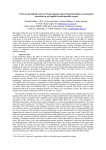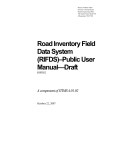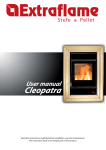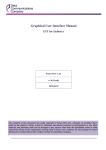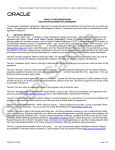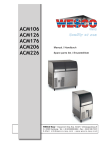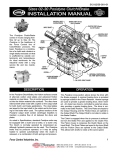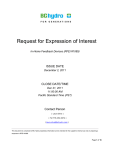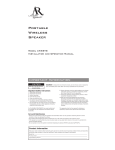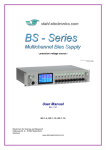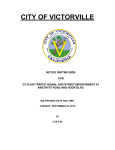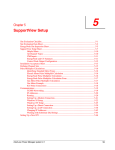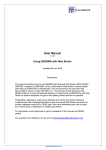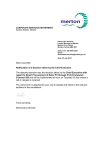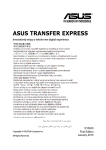Download Device Selection Methodology - Data Communications Company
Transcript
Device Selection Methodology Device Selection Methodology (DSM) V1.0 13th November 2014 DCC Public Page 1 of 20 Device Selection Methodology Contents 1 Introduction ................................................................................................ ................................ ...................................... 3 1.1 Test Phases ................................................................................................ ................................ ................................ 3 1.2 Types of Meter Devices................................................................ ............................................... 3 2 Number of Devices ........................................................................................... ................................ ........................... 6 3 Device Selection Process ................................................................ ................................................ 8 3.1 Overview of Selection Process. ................................................................ ................................... 8 3.2 Stage 1 – Selection ................................................................ ..................................................... 9 3.3 Stage 2 – Participation Agreement ............................................................ ............................ 11 3.4 Stage 3 – Mobilisation ................................................................ ............................................... 11 4 Device Lists and Device De-Selection De Process ........................................... ................................ 12 4.1 Equipment under Test ................................................................ ............................................... 12 4.2 Substitutes ................................................................................................ ................................ ................................ 12 4.3 Device De-selection selection ................................................................ .................................................. 12 4.3.1 Issue Resolution & Device De-selection De ................................ ............................................. 13 4.3.2 Escalation of De-Selection De Decision ................................................... ................................ 13 5 Meter Device Model Selection Criteria .......................................................... .......................... 14 6 Insufficient Compliant Devices ................................................................ ..................................... 18 1. Glossary ................................................................................................ ................................ ....................................... 19 DCC Public Page 2 of 20 Device Selection Methodology 1 Introduction This document is the Device Selection Methodology (DSM), which is published following its consultation between the 12th September and 13th October 2014. The DSM sets out the process by which Devices will be selected for use in testing1, and de-selected, by the DCC in accordance with the provisions of the Smart Energy Code (SEC)2. In selecting Devices via the DSM, the DCC will not give any consideration to the relative ‘quality’ of one Device in relation to another. Neither will the DCC test the functionality of the Devices. 1.1 Test Phases The manner in which the Devices will be used during each ach test phase is described below. Systems Integration Testing (SIT) SIT tests the capability of the DCC systems, together with communication ommunications hubs, to interoperate with each other and with the Registration Data Provider (RDP) ( systems. This testing will be undertaken with all available communications hub ub variants and with the metering equipment that is obtained via this selection methodology. Users will not participate in this test phase and Service Service Requests will be injected into the DCC User Gateway via a service user simulator. Interface Testing (IT) and User Entry Process Tests (UEPT) Prospective users sers may conduct User Entry Process Tests (UEPT) during the Interface Test stage3. UEPT will be conducted onducted against the metering Device Models with which the DCC successfully completes SIT. These Devices will also be used as the basis for conducting UEPT4 during the End to End Test stage and Enduring Test phase. 1.2 Types of Meter Devices The minimum criteria ia that must be met by selected Devices are set out in the SEC which requires that Devices are: SMETS compliant, provided that they need not (where the Secretary of State so directs) have a ZigBee Alliance Assurance Certificate or DLMS Certificate and ________________________ 1 Systems Integration Testing (SIT), Interface Testing (IT) and User Entry Process Tests (UEPT) will be undertaken using (to the extent reasonably practicable) actual Devices rather than Test Stubs or other alternative arrangements. 2 st Version 3 of the SEC, effective 31 July 2014 3 The SEC obliges all Large Supplier Parties to be ready to commence UEPT at the start of the Interface Test stage 4 UEPT will be conducted using the Device Models that are selected via this DSM. In accordance accordan with Section H14 .9 b) of the SEC, the Panel may approve the use of alternative Device models from time to time. The manner in which these alternative Device Models will be selected will be set out in the Enduring Test Approach Document which will be published p on the DCC website. DCC Public Page 3 of 20 Device Selection Methodology need not have a CPA Certificate until CPA Certificates are generally available for the relevant Device Type (and the DCC need only switch to a Device Model with those Assurance Certificates where it is reasonably practicable for it to do so, having regard to the timely achievement of the Testing Objectives); Objectives); selected so that,, in respect of each Communications Hub Device Model that the DCC first proposes to make available pursuant to the Communicaton Services, there are two Gas Meter Device Models and two Electricity ectricity Meter Device models of a manufacturer which is not the Manufactirer (or an Affiliate of the manufacturer) of that communications c Hub Model Device; and available in sufficient volume to support the requirements of Systems Integration Testing, Interface rface Testing and User Entry Process Tests. The SMETS provides for several different Electricity Meter Device Model variants. Having carefully considered the objectives of testing, the DCC intends to select the following variants5 Single element Electricity Electricit Meter Device Models (as in part A of SMETS); Single element Electricity Meter Device Models (as in Part A of SMETS) with auxiliary load control and boost switch functionality (as per Part D & E of SMETS); and Twin Element Electricity Meter Device Models (as in Part B of SMETS). This will enable testing to be undertaken using the majority of the Service Requests Reques that are set out in the SEC. A limited number of specific Service Requests are required for communication with additional Type 1 HAN Devices6 and for use with local devices such as Hand Held Terminals. The DCC understands that compliant versions of these additional Devices will not be available at the start of SIT, and these Devices will not be selected via this Device Selection Methodology. We therefore intend to test the relevant Service Requests by using simulators. However, we encourage Device manufacturers to contact the DCC if additional SMETS compliant Type 1 HAN Devices can be made available during SIT.7 The DCC will also consider any requests that are made by the manufacturers of In Home Displays (IHDs) and Consumer Access Devices (CADs) for use in SIT on the basis that: the DCC reserves the right to reject any request that may have an adverse impact on the completion of SIT; ________________________ 5 The DCC understands that it is unlikely that compliant Poly Phase Electricity Meter Device Models will be available at the start of SIT. The difference between a single and polyphase meter (in terms of communication with the he DCC) is the generation of a ‘lost phase’ alert from a poly phase meter. This will be simulated during SIT – although the DCC will consider using a poly phase meter if any are available. 6 For example, Pre-Payment Payment Interface Devices (PPMIDs) and HAN Controlled Controlled Auxiliary Load Control Switches (HCALCS) 7 Contact details will be provided on the DCC website, along with details of the compliance evidence that will be required and the timescales within which Devices will be considered for use. DCC Public Page 4 of 20 Device Selection Methodology Devices must meet acceptance criteria that are specified by the DCC and published on its website; and Functionality testing of the IHD and CADs will not be undertaken. DCC Public Page 5 of 20 Device Selection Methodology 2 Number of Devices The DCC may select as many different Devices as it considers appropriate in order to demonstrate that the Testing Objectives8 have been achieved, provided that at least the first two Device Models per fuel type are selected that are offered in accordance with the DSM. The DCC intends to make available availa five Communications Hub ub variants9 to Supplier Parties and each variant will be used in SIT, IT and for the purposes of UEPT. The DCC is required to test each Communications Hub with at least two Electricity Meter Device Models and two Gas Meter Device Models from Device manufacturers that are not the manufacturer (or an Affiliate of the manufacturer) of the Communications Hub. When considering the number of Meter Device Models to use in testing, the DCC has taken into to account its requirement to: act in n an economic and efficient manner; provide assurance that the DCC’s systems function correctly; and maintain sufficient flexibility in the testing process to avoid introducing unnecessary delay by selecting too large a volume of meters, or too small a volume volume to provide an adequate level of assurance. This intent will be achieved by selecting: six Electricity Meter Device Models (to allow for two models of each variant type, where available); and four Gas Meter Device Models. If the full range of requested requested variant Electricity Meter Device Model types is not available: a) DCC will select six Electricity Meter Devices Models from the variants that have been made available; and b) will use test stubs to simulate responses to those Service Requests that cannot not be received by the available meters. meters ________________________ 8 SIT Objectives are set out in Section T2.2 of the SEC. IT Objectives are set out in Section T3.2 of the SEC. 9 CSP N will use one Comms Hub variant for SIT, provided by EDMI. EDMI CSP C/S will be using four Comms Hub variants for SIT, provided by Toshiba and WNC: Cellular only - WNC Cellular only – Toshiba Cellular and Mesh, cellular aerial port – Toshiba Cellular and Mesh, 2 aerial ports – Toshiba. DCC Public Page 6 of 20 Device Selection Methodology The DCC has considered the number of Devices that will be required to support SIT and UEPT, based upon the number of prospective Users that could be conducting UEPT at the start of Interface Testing and has determined ed that a maximum of one hundred and twenty units of each of the Gas Meter Device Models and a maximum of eighty units of each of the Electricity Meter Device Models will be required. required This can be accommodated by utilising the maximum capacity of both CSP test t labs. The DCC considers that this volume of Device Models will provide a high level of assurance that DCC systems operate correctly and meet the requirements of all test participants at the start of the Interface Test Stage. Stage It is important that the manufacturer anufacturer of any selected Device Model can provide the number of Devices set out in the Device Selection Methodology. Failure to secure a sufficient number of Devices could result in a delay to the testing process and an overall delay to the Smart mart Metering Implementation Programme.. In the event that no Device manufacturers can provide the requested number of Devices, the DCC will, at its discretion, use test stubs or Devices from a larger number of manufacturers. In making its decision, the DCC will take into account the level of assurance that can be gained through the use of test stubs, the shortfall in the number of Devices that can be provided by the Device manufacturers and the impact of testing with a greater variety of Meter Devices on SIT. SIT Device Models will only be considered for selection where the Device manufacturers have complied with the requirements of the DSM, including the Device selection criteria10. These criteria require the provision of technical support by the Device manufacturer, including uding instruction manuals and training. All selected Meter eter Device Models must be configured in a standard format that will be prescribed by the DCC and published as part of the ‘Invitation to Participate’ during the selection process. The Meter Device Models will be utilised in a test set with a Communications Hub provided by a manufacturer which is not the manufacturer (or an Affiliate of the manufacturer) of the Meter eter Device Model. A test set comprises one Communications Hub, one Electricity Meter Device Device Model and one Gas Meter Device Model. ________________________ 10 Unless these criteria have been relaxed by the DCC in accordance with this document. DCC Public Page 7 of 20 Device Selection Methodology 3 Device Selection Process 3.1 Overview of Selection Process. The selection process consists of three stages as illustrated below, and these will be completed prior to the start of SIT. Figure 1 - Device Selection Process Overview DCC Public Page 8 of 20 Device Selection Methodology 3.2 Stage 1 – Selection The following diagram illustrates the process by which Devices will be selected. Figure 2 - Device Selection Process Stage 1 DCC Public Page 9 of 20 Device Selection Methodology The DCC will publish an ‘Invitation to Participate’ in testing on the DCC website and will notify all relevant ant bodies, including: SEC Parties, the Government, the Authority, BEAMA, Energy UK and the EUA. Device manufacturerss will be asked to submit an Expression of Interest (EOI) in accordance with requirements that are set out by the DCC, including the provision provisi of a preliminary set of information, and to confirm that they have understood the requirements set out in the DSM. They will also be required to sign an appropriate Non-disclosure disclosure Agreement (NDA) which will be provided by the DCC. The DCC will provide an application submission pack to all Device manufacturers manufacturer that have submitted a complete and compliant EOI and signed the NDA. The pack must be completed in accordance with instructions provided by the DCC and within a deadline provided by the DCC, which will not be less than two weeks following the provision of the e application submission pack. Non-compliant compliant applications will be rejected. Manufacturers may submit up to four Device Models for selection but must complete a full application submission for each each model. Where multiple Devices are submitted the manufacturer must indicate which Device it would prefer to be selected. The DCC will review the submissions and assess whether they meet me the DSM selection Criteria. The first four Gas Meter Device Models and the first six 11 Electricity Meter Device Models that are received by the DCC in accordance with the DSM and that meet the selection criteria will be used for testing and placed on an ‘Equipment under Test’ list. All other Devices that are submitted in accordance with the DSM and which meet the selection criteria will be added to a ‘Substitute Device’ list. These substitute Devices will be used in priority of earliest submission if any of the original models are dede selected. Prior to confirming that a Meter Device Model has been selected (or has been placed on the Substitute Device List), the DCC reserves the right to perform some limited testing with the Device via the CSP test labs or by using a test reference tool12. These tests ests will be used to confirm that the Devices can receive a limited number of Service Requests (including future dated commands) and return Responses and Alerts. Device manufacturers will be required to support this activity and may be provided with the opportunity portunity to rectify any issues identified with a Device. This activity will not imply that a Device has been certified by the DCC or confirm that a Device is GBCS compliant. The DCC may reject Devices based upon the results of these tests. The DCC will publish its decision on which Device Models have been selected on the DCC website. All manufacturers of selected Devices will be notified of the date upon ________________________ 11 Unless the DCC determines that a different number of Device Models per fuel type will be used due to insufficient Devices. The DCC will publish the reasons why a different number of Device Models has been selected. 12 The details of any test reference tool that is used will be published on the DCC website DCC Public Page 10 of 20 Device Selection Methodology which Devices will be required and the location of the CSP test lab in which the Devices will be used. The DCC will not publish a list of Devices that are not selected or which are deselected. The DCC will publish the manner in which the selection criteria have been relaxed, should it be necessary to do so. 3.3 Stage 2 – Participation Agreement Meter Device e Models will be allocated to a specific Communications Hub variant for the duration of the testing process, unless they are de-selected de selected by the DCC in accordance with the DSM. Device Models will not be used in testing unless the Device manufacturer has signed sig a participation agreement confirming that it can fulfil the participation obligations including: provision of the required number of Devices models for SIT and UEPT; UEPT provision of sufficient test resources to support the rapid diagnosis and resolution of issues arising during testing; and provision of resources to support installation of Devices in test labs and training of CSP resources to install and operate Devices. 3.4 Stage 3 – Mobilisation Device manufacturers anufacturers must ensure that the required numbers of Devices are delivered to the correct CSP test lab facility and that sufficient technical support is available to correctly set up, install in and replace the Devices. The Devices De will be delivered to the test labs in accordance with a schedule that is agreed between the Device manufacturer and DCC, and which will be set out in the Participation Agreement. In any event, the Device manufacturer must maintain a sufficient quantity quanti of Devices in stock to enable delivery to the CSP test labs in timescales which will not adversely impact upon DCC’s test activities. At least four weeks prior to the start of SIT, SIT the Device manufacturers must supply and set up five units of each meter meter Device Model in the allocated test lab/s. This will enable the DCC to confirm that the Devices have been configured correctly and can be installed with the e selected Communications Hub. The Device manufacturers will also be required to train the CSP staff to operate the Devices (to the extent necessary for testing purposes). purposes At least two weeks prior to the beginning of SIT meter Device Models must be delivered to the CSP test labs, in accordance with the agreed delivery schedule, to allow final set up of the he Devices for use in SIT. Final set up for SIT must be completed five working days before the start of SIT. DCC Public Page 11 of 20 Device Selection Methodology 4 Device Lists and Device De-Selection De Selection Process 4.1 Equipment under Test The selected Device models will be placed on an ‘Equipment Equipment under Test’ Test list and one Gas Meter Device Model and one Electricity Meter Device Model will be used in conjunction with a specific Communications Hub variant to form a Test Set. 4.2 Substitutes All Meter Device Models that meet the selection criteria but which have not been selected will be placed on a Substitute Device List in a priority order determined by the time at which their application was received recei by the DCC. In the same manner as stated previously, the DCC reserves reserves the right to conduct limited testing with the Devices before they are placed on the Substitute Device List. The Devices on the Substitute Device List will be used for testing if a selected meter Device Model is: de-selected; selected; has been withdrawn from testing by the Device manufacturer; or is no longer available for testing for some other reason. When the need for a substitute Device Model has been identified, the relevant Device manufacturer will be invited to participate in testing. If the Device manufacturer man does not confirm that it wishes to participate within two working days, the next Device on the Substitute Device List ist will be selected selected and the process repeated. Those Device manufacturers that agree to participate will be required to install an agreed agreed number of Device Models at the CSP Test lab(s) within five working days. The DCC will maintain the Substitute Device List ist for as long as it deems necessary during SIT, Interface Testing and UEPT. 4.3 Device De-selection selection A Meter Device Model can be de-selected de elected from a test set at the discretion of the DCC in accordance with the criteria that are set out in Table 1 below. below. The DCC will dede select Device Models where the potential impact on the testing activity and overall programme warrants de-selection. selection. For example: de-selection selection will not occur if a single unit of a specific Device model does not respond to a Service Request. If a Device Model is de-selected selected then all of the units of that Device model will be removed from testing. The Device manufacturer may refer r the DCC’s decision to de-select select a Meter Device Model to the SEC Panel if it believes that the DCC has not complied with the DSM. The SEC Panel’s decision may be appealed.13 Note: issues that arise during SIT will not automatically automatically be attributed to the Meter Device Model. The DCC will undertake root cause analysis to determine if the fault resides with its own systems. ________________________ 13 In accordance with Section T1.3 b) of the SEC. DCC Public Page 12 of 20 Device Selection Methodology De-selection Criteria The Device Manufacturer is found to be in breach of its Participation Agreement for whatever reason. SIT would be delayed by continuing to attempt to use the Device Model. Model Table 1 - De-selection criteria 4.3.1 Issue Resolution & Device De-selection De The DCC will provide test results and test logs to the relevant Device manufacturer if a test issue is identified with a Device Model. Model. Severity levels will be allocated to each issue, along with a timescale within which the issue should be resolved, and these will be agreed with the Device manufacturer. If the Device manufacturer is unable to close the matter within the agreed timescales but can provide evidence that the issue can be closed in timescales that will not adversely impact SIT, it shall be at DCC’s discretion to de-select, de select, or continue testing with, that Device Model. Notwithstanding the above, the DCC will retain the right to de-select de select Device Models if a significant number of defects are found with any particular Device Model. Device manufacturers can apply to the DCC to place de-selected de Devic Devices on the Substitute Device List, on the proviso that any issues that have been identified with the Device have been resolved. A Device manufacturer may raise (and escalate) a Testing Issue at any point in time during SIT, IT or UEPT14. The results of all Testing Issue ssue resolution activities (regardless of whether the issue was escalated) will be published on the DCC’s website in redacted form for the benefit of all Device manufacturers. 4.3.2 Escalation of De-Selection De Decision A Device manufacturer may escalate escalate an issue to the SEC Panel if it does not agree with the DCC’s determination to de-select de select a Device. In so doing, the Device manufacturer must comply with any information that is requested by the SEC Panel. In the event that the SEC Panel rules in favour of the Device manufacturer, the Device will remain on the ‘Equipment under Test’ list. In the event that the SEC Panel rules in favour of the DCC, the Device will be dede selected. The Device manufacturer may re-submit re submit the Device to the DCC for inclusion on the Substitute Device List if the reason for de-selection selection has been remedied. The Panel’s decision may be appealed to the Authority (or, where the Secretary of State so directs, to the Secretary of State or such other person as the Secretary of State directs) ts) for final determination. ________________________ 14 In accordance with Section H14.37 of the SEC. DCC Public Page 13 of 20 Device Selection Methodology 5 Meter Device Model Selection Criteria The table below contains the criteria that each submitted Meter Device Model must meet to be considered for selection. Each Meter Device Model submission will be evaluated against the criteria by the DCC and the first15 first four compliant submissions that are received by the DCC for Gas Meter Device Models and the first six compliant submissions that are received by the DCC for Electricity Electricity Meter Device Models will be selected for use during Systems Integration Testing, Interface Testing and User Entry Process Tests. The DCC may relax these criteria if so required, for example if no fully compliant meters are available as set out in Section Sect 6. Ref Selection Criteria Evaluation method 1 Application Compliance Application submission pack to be fully completed and compliant Review application submission 2a SMETS Compliant (excluding CPA certification) The Meter eter Device Model must be provided with a declaration of conformity to SMETS (noting any exemptions that may be issued by the Secretary of State) from the Device manufacturer Self- declaration of conformity with supporting information, including evidence of testing that has ha been undertaken to demonstrate compliance with the requirements set out on SMETS. Note: The Device Manufacturers will not be required to warrant that their Devices are compliant with SMETS 2b (i) DLMS Certification Certification evidence DLMS Certification against Bluebook v12 & Greenbook v8 (Electricity ( Meters only) (unless this criteria is relaxed by the Secretary of State) 2b (ii) Zigbee Certification Zigbee Certification Version SEP 1.2a v1.0 certification. (unless this criteria is relaxed by the Secretary of State) Certification evidence ________________________ 15 The window within which Devices Devices must be submitted will be provided within the Invitation to Participate. Submissions that are received within this window will be time stamped with the date and time of receipt. DCC Public Page 14 of 20 Device Selection Methodology 3 CPA certification Priority will be given to Meter Device Modelss with CPA certification if this is generally available for the relevant Device type Evidence of CPA certification. certif 4a Sufficient Number of Units Sufficient number of units of each Meter Device Model M available to commence SIT Declaration of conformity followed by supply chain check (for example, to confirm: adequate production capacity; delivery schedule set out in the Participation Agreement) 4b Sufficient Number of Units The Device manufacturer must confirm that the DCC has access to the required number of units of each Device Model at all times through SIT, Interface Testing and UEPT. Declaration of conformity and statement of the manner in which operational numbers will be maintained/ managed. 5 Non-Affiliation Manufacturer of the Meter Device Model must not be the manufacturer (or an Affiliate of the manufacturer) of a Communications Device Model with which the meter Device will be tested Manufacturer to declare known affiliations. DCC to review affiliations and nominate meters to suitable test sets. 6a Support Requirements – User Manuals Fit for purpose user manuals provided to enable physical installation, pairing and commissioning instructions and unit removal and replacement to be carried out Suitable manuals supplied 6b Support Requirements – Primary Contact The Device manufacturer must provide a suitable primary contact to attend the Incident Review Board and co-locate locate at DCC as reasonably required Declaration of availability provided plus profile of contact. 6c Support Requirements Technical Support Meter Subject Matter Expert(s) Expert (SME) available for installation and triage/issue resolution during SIT and Interface Testing for a minimum of 400 hours (excluding travel) per model. The hours will be allocated as needed across SIT and Interface Confirmation of ability to meet requirement and statement of manner in which the manufacturer will provide support. DCC Public Page 15 of 20 Device Selection Methodology Testing and the manufacturer can provide the type and level of support appropriate to the specific stage of the test programme. The SMEs MEs should have ZigBee protocol experience for Electricity and Gas Meter Device Models and DLMS protocol experience for Electricity Meter Device D Models. The SMEs should have been involved in the development of the product and those SMEs involved in the installation stallation of the Devices should hold relevant qualifications. qualifications 7 Device Stability/ Maturity The proposed Meter M Device Model must be ‘stable’.’. At entry point, all units of the same model should be supplied with no variation i.e. supplied with the same hardware and software. No prototypes will be accepted Note: firmware updates will be allowed prior to delivery of the meters and once testing has begun on the condition that all Meter Device Models are updated. Any firmware updates that are made prior to testing must not breach the Device selection criteria 8 Quality & Safety Assurance The Devices should have been produced in accordance with a defined quality assurance process and a defined defect management/configuration management process The Device must be safe to install and operate DCC Public Confirmation onfirmation of model supplied including: The type of Device(s) put forward for testing (e.g. ESME single phase, GSME) The model identifier of the Device The hardware version of the Device The firmware version of the Device All known outstanding defects The variant/configuration identifier of the Device (each variant and/or configuration will be treated as a separate device) Evidence of the extent of Device Testing undertaken by manufacturer, including test results, outstanding defects and rectification plans. Firmware up grade procedure, including over the air upgrades. Configuration management procedures Manufacturer statement regarding the processes used. Evidence that all the supplied Devices are safe to store, install, operate and decommission. This may be in the form of Page 16 of 20 Device Selection Methodology statement of compliance with the relevant parts of the CE marking standard or equivalent. Please note: that the DCC will be using air not gas to conduct the tests using the Gas as Meter Device Models. 9 Compatibility/physical connection co The Electricity Meter M Device Models should have a Communications Hub physical interface that is compliant with the Intimate Communications Hub Interface Specification (ICHIS) Declaration of compliance from Device manufacturer Table 2 - Selection Criteria DCC Public Page 17 of 20 Device Selection Methodology 6 Insufficient Compliant Devices Where the DCC is not able to select Meter Device Models that meet all the criteria set out in the SEC, it may relax these criteria16 and may also choose to relax the additional selection criteria that are included within this document, where necessary. The DCC reserves the right to determine that meter test stubs should be used instead of Meter Device Models that have been selected against ainst ‘relaxed criteria’ (for example: if the DCC considers that the test stubs provide a greater level of assurance). The DCC will publish the reasons for relaxing the selection criteria, and the manner in which the relaxation has been applied, and will also publish the reasons why it has chosen to use meter test stubs and the level of assurance that will be attained. However, it is the preference of the DCC to use Meter Device Models for SIT, Interface Testing and UEPT to provide the highest level of assurance ssurance that the DCC's systems function correctly. Therefore, the DCC intends to use Meter Device Models that meet the minimum selection criteria that are set out in the SEC when these are made available as set out below, as long as the DCC considers that this will not disrupt testing at that time: The DCC will notify the SEC Panel that insufficient compliant Meter Device Models are available; The DCC will re-publish publish the Invitation to Participate in SIT on its website with a ‘time window’ within which compliant com Meter Device Models may be put forward for use in testing; The DCC will check that evidence of compliance has been provided for any Meter Device Models that are put forward within this time-window time window and may decide to undertake some limited interoperability interoperab tests on the Device; If the checks and tests are successful, the DCC will notify the Device Manufacturer, agree the volume of Meter Device Models that are required and the timescale within which they must be installed in the CSP test labs; and If more than six electricity Meter Device Model variants and four gas Meter Device Model variants become available, the DCC will use those Devices that are provided first and the remainder will be placed on the Substitute Device List. In the event that no Meter Device Models can be made available within the ‘time window’, the DCC will notify the SEC Panel that SIT will be completed using meter test stubs and will set out the level of assurance that will be achieved. In this event, the DCC will agree a process with wit the Panel by which meter Device Models can be selected for use in UEPT and the Meter Device models that are selected by this process will be presented to the Panel for approval prior to their use17. ________________________ 16 Section T1.5 of the SEC. 17 In accordance with SEC H14.9b) DCC Public Page 18 of 20 Device Selection Methodology 1. Glossary Term in Use Explanation Affiliate (affiliation) in relation to any person, any holding company of that person, any subsidiary of that person or any subsidiary of a holding company of that person, in each case within the meaning of section 1159 of the Companies Act 2006. CSP Communication Service Provider. Communications DCC subject to Section M9 (Transfer of DCC Licence), the holder from time to time of the DCC Licence. References to the DCC shall (where applicable) include references to the DCC Service Providers with whom the DCC has contracted in order o to secure performance of its obligations under the SEC. Device one of the following individual devices: a) an Electricity Smart Meter; b) a Gas Smart Meter; c) a Communications Hun Function; d) a Gas Proxy Function; e) a Pre-Payment Pre Payment Interface; f) an Auxiliary Load Control; and g) any Type 2 Device. Device Model in respect respect of a Device, the Device’s manufacturer, model, hardware version, including, where applicable, the Meter Variant (as defined in the SMETS). DSM means, Device Selection Methodology. DSP Data Service Provider. Electricity Meter any meter that conforms to to the requirements of paragraph 2 of schedule 7 to the Electricity Act and is used for the purpose of measuring the quantity of electricity that is supplied to premises. Gas Meter a meter that conforms to the requirements of section 17(1) of the Gas Act for the purpose of registering the quantity of gas supplied through pipes to the premises. GBCS Great Britain Companion Specification. HAN for each Smart Metering System, the home area network created by the Communications Hub Function forming part of that Smart Metering System. ICHIS Intimate Communications Hub Interface Specification IT Interface Testing. PIT Pre-Integration Integration Testing. RDP Registration egistration Data Provider; Electricity Distributor or Gas Transporter responsible for providing (or procuring the provision of) Registration Data in respect of a particular MPAN or MPRN. SEC Smart Energy Code. DCC Public Page 19 of 20 Device Selection Methodology SIT Systems Integration Testing. SMETS the Smart Metering Equipment Technical Specification. SMIP Smart Metering Implementation Programme. SMKI Smart Meter Key Infrastructure. SP Service Provider. Test Stub/s systems and actions which simulate the behaviour of Devices and User Systems. UEPT User Entry Process Tests. Table 3 - Glossary DCC Public Page 20 of 20




















